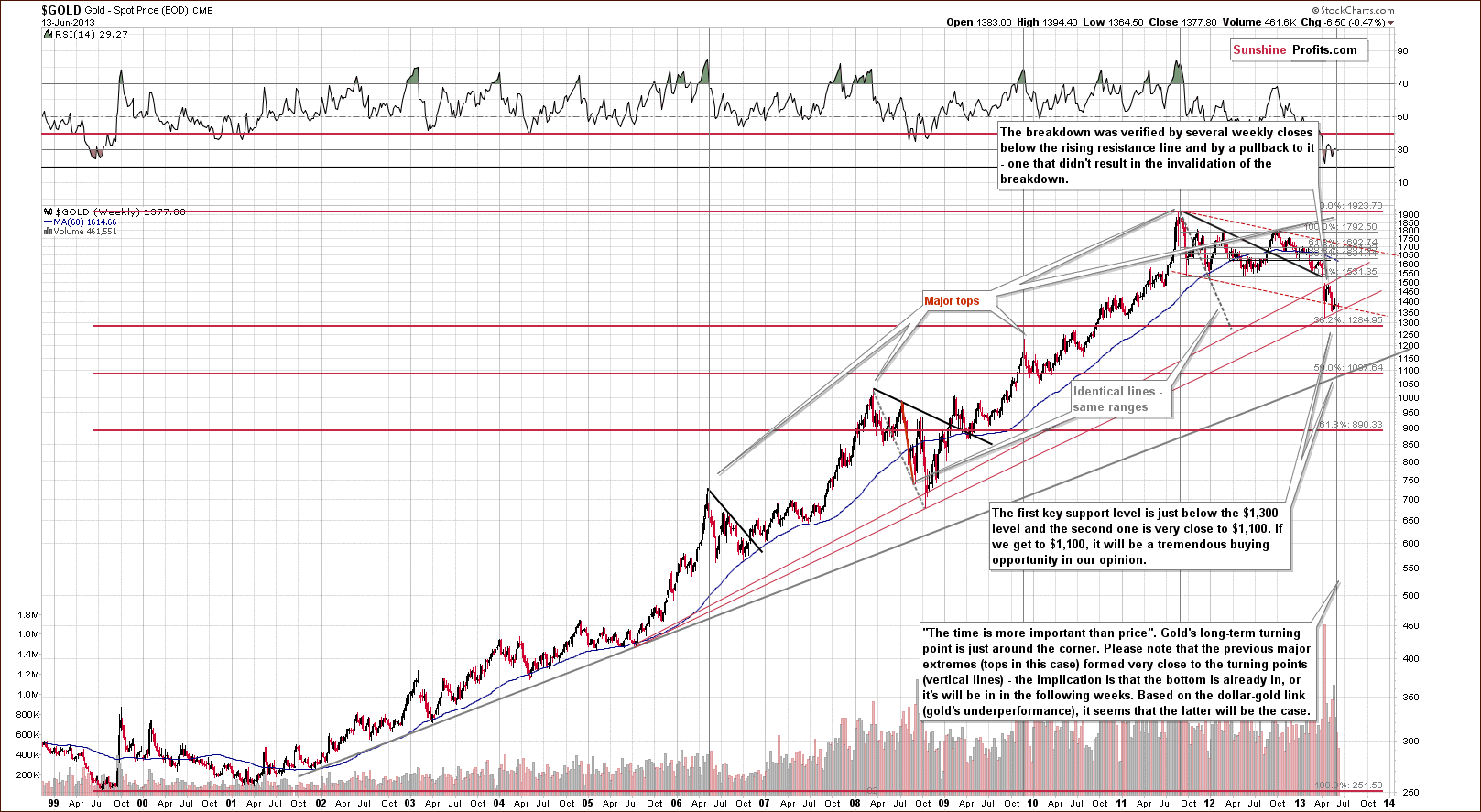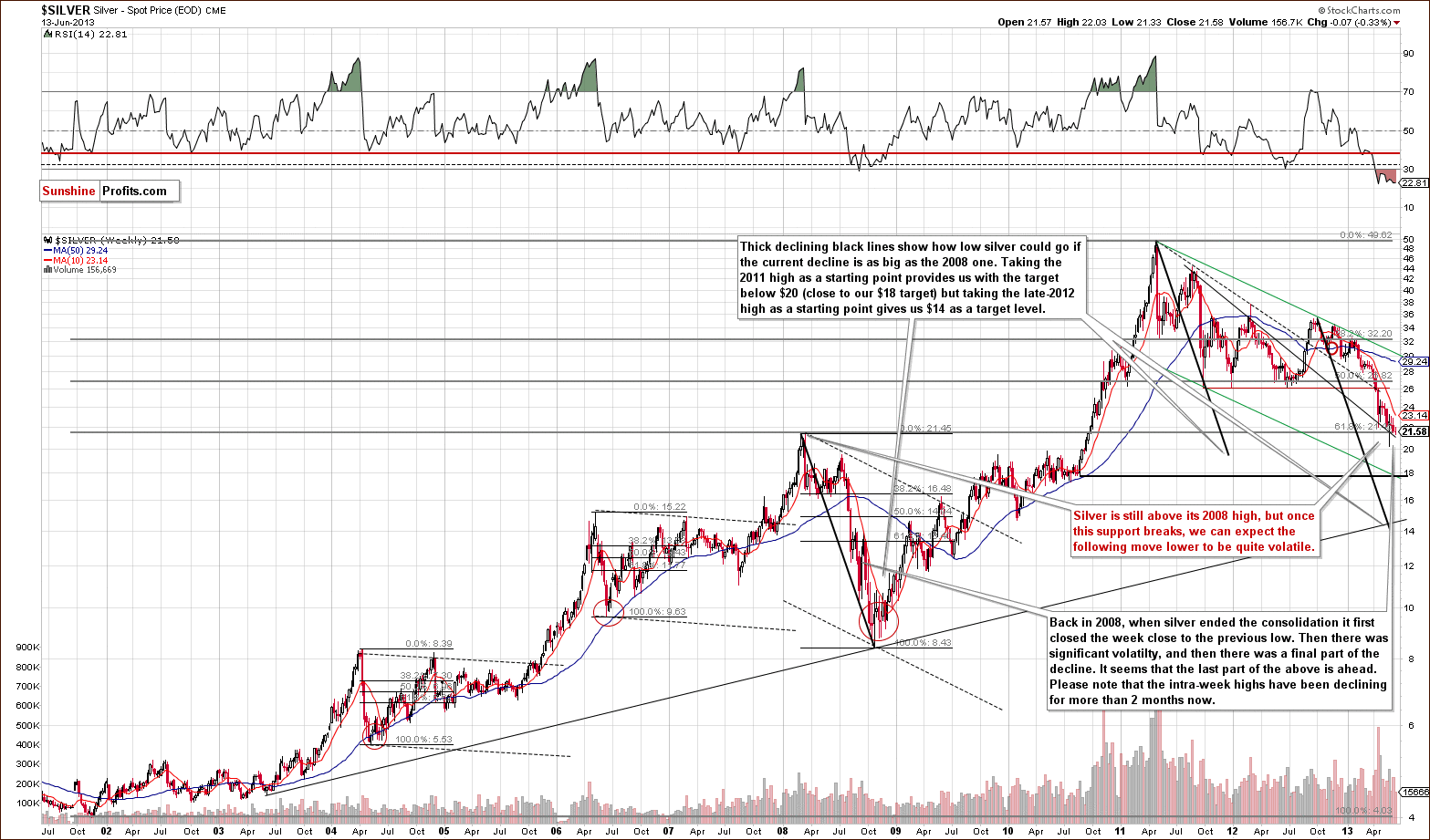Richard Russell: “What to do? I’ve never had such an overwhelming feeling that the cards are stacked against us, the retail or ‘non-professional’ investors. The bond market is held up by the Fed. The stock market is levitated by the Fed’s QE. The gold market is rigged by big banks and an assortment of manipulators. The art and jewelry markets are owned by the world’s billionaires. Farm land is owned by the wealthy. So again, what do we do? Or what should we do?
Gold & Precious Metals
Gartman: ‘Gold Is A Broken Commodity’
Posted by Dennis Gartman - The Gartman Letter
on Sunday, 16 June 2013 17:09
Dennis Gartman, Founder and Publisher of The Gartman Letter, gave a very interesting interview on CNBC where he shared his insights into gold. His take home messages were:
-
The high in gold is almost 2 years behind us.
-
We’ve failed to make a new high and broken many trend lines support.
-
Gold is a broken commodity and is likely to head lower.
-
Gold is likely to head lower even with all the news of the Fed expanding reserves to the system.
-
The trend seems to be downward, and if $1,200 is broken, the next level of support is $1,000.
CNBC commentator Brian Sullivan provided the best insight of the video when he described gold as an aging athlete, where it still has its fans, but its best days are behind it, and it is unlikely to repeat the glory days. Brian put it best when he says “gold’s had its day.”
The second best insight provided in the video is an observation I’ve made many many many times in other articles. If gold can’t rally on all the good news out there, what will make it rally? Dennis put it best when he said “the oldest rule in commodity trading is that if something can’t rally when the news is bullish, it is a bear market.”
In conclusion:
because gold is simply valued upon what someone else is willing to pay for it, the simplest methods of valuation are often the best. Gold doesn’t generate a cash flow, there is simply a supply and demand, and where the two meet is the price. Supply is pretty much fixed in the short run, so demand becomes the determining factor for the price. Demand is shifted by the news and outlook for gold. Currently, even with all the good news that should be bullish for gold, the price continues to deteriorate. In my opinion the aging athlete is an excellent analogy for gold, and the markets seem to be agreeing that it is simply time to retire gold and move on to the next emerging bull market.
(click HERE or on image to watch in full)
Disclaimer: This article is not an investment recommendation. Any analysis presented in this article is illustrative in nature, is based on an incomplete set of information and has limitations to its accuracy, and is not meant to be relied upon for investment decisions. Please consult a qualified investment advisor. The information upon which this material is based was obtained from sources believed to be reliable, but has not been independently verified. Therefore, the author cannot guarantee its accuracy. Any opinions or estimates constitute the author’s best judgment as of the date of publication, and are subject to change without notice.

Have Gold and Silver Stopped Responding to US Dollar’s Price Action?
Posted by Przemyslaw Radomski - Sunshine Profits
on Friday, 14 June 2013 15:47
Gold cannot be printed or manufactured in contrast to paper currency. That’s why it has kept its value as the ultimate currency over the long term. There can be no “gold war.” However, we often hear about a “currency war.” Sounds familiar — where did we hear this before?
The phrase “currency war” was coined by Brazilian Finance Minister Guido Mantega after the financial crisis of 2008. The idea is that highly indebted nations weaken the value of their currency by cutting interest rates down to zero and printing fiat currency in order to gain trade advantages (cheaper products to export) and to pay lessdebt service on their bonds. Countries compete against each other to achieve a relatively low exchange rate for their own currency. The policy can trigger retaliatory action by other countries that in turn can lead to a general decline in international trade, harming all countries.
Concerns over a currency war prompted the Group of Seven and Group of 20 economies recently to formulize what constitutes appropriate behavior by central banks in influencing currency exchange rates.
Let’s look at some numbers. Global currency reserves have swelled from $1.9 trillion in the year 2000 to a whopping $11.2 trillion by the third quarter of 2012. But most of that gain took place during the past six years with global currency reserves doubling to the current levels from $5.6 trillion at the beginning of 2007. If that is not evidence of the global currency war, then what is? There are two different examples to consider. The first is undeniable evidence of aggressive money printing. The second is an indication of determined stockpiling of the currencies of other countries in order to weaken your own currency.
For a widespread currency war to occur, a large proportion of significant economies must wish to devalue their currencies at once. This has so far only happened during a global economic downturn.
Under normal economic conditions, countries tend to overlook a small rise in the value of their own currency. However, during a time of recession, nations can take umbrage at other countries’ devaluations.
Let’s begin this week’s technical part with the analysis of the US dollar’s long-term chart. (Charts courtesy of http://stockcharts.com.)
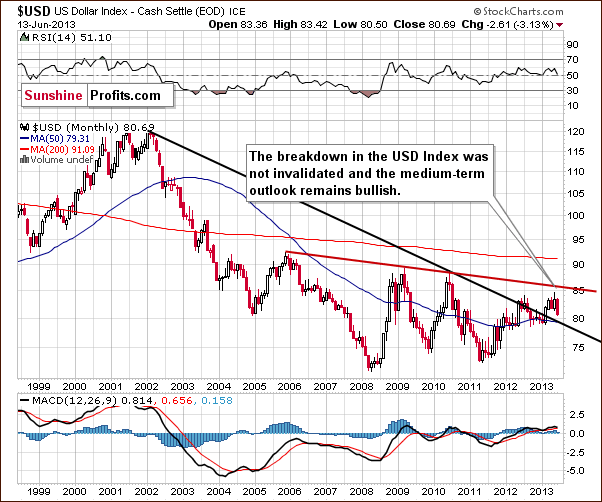
When we take a look at the above chart, we can see that the USD Index declined once again this week. Despite that fact, the January breakout was not invalidated. As we see, the index is still above the declining support line, and thus the medium-term outlook remains bullish.
Let’s take a look at the medium-term situation. Has it changed since last week?
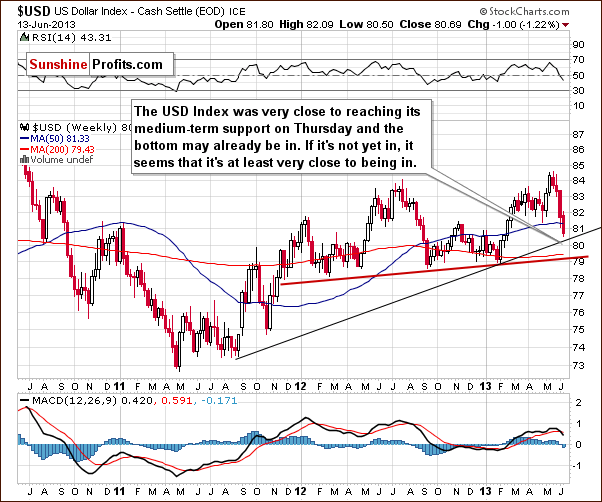
Here we can see that the USD Index moved to its medium-term support line (marked with the thin black line), which is currently close to 80.4. It is very possible that this line will pause the decline, at least for a while, and it’s quite possible that it will actually stop it.
The situation remains bullish for the USD Index in the long term and medium term, so let’s check to see if the short-time outlook is the same.
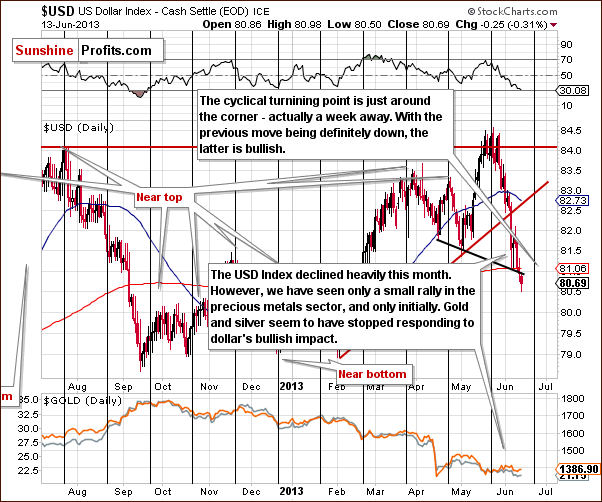
During the last several days, the USD Index declined and moved slightly below the short-term support line. There is a medium-term support line visible on the previous chart that is much more important so the above is actually not a big deal.
The most important factor on the above chart supporting the bullish case is the cyclical turning point, which is very close – about a week away. It is possible that we will see its impact on the dollar next week and this can lead to a bigger pullback or – more likely – the end of the current decline. If we move back in time a bit, we will see similar situation in August and September 2012, which is when the cyclical turning point worked very well after a significant decline.
Additionally, please note that the RSI Indicator is now at the 30 level, which is a classic buying opportunity.
Let’s find out what impact has this decline had on the two most popular precious metals. (click on image or HERE for larger version)
In this week’s very long-term gold chart, comments I made last week remain up-to-date:
We are still likely to see declines after the cyclical turning point from this long-term perspective. The turning point should work on a “near to” basis, and declines will likely be seen sooner rather than later (and the bottom is likely weeks away, not months away).
Now let’s take a look at the white metal. (click on image or HERE for larger version)
In this week’s very long-term silver chart, not much really happened as prices declined slightly, less than half of 1% overall. The intraday high for the week was lower than last week once again; from this perspective, the declines clearly go on.
No confirmed move has been seen below the level of the 2008 highs, but silver’s price is only slightly above it at this time. It seems that we’ll have another sharp decline once the breakdown below this support level is seen and confirmed.
Summing up, the most important event in the currency market was the further decline of the dollar. Although the decline visible on the USD Index chart has been quite heavy, we have not seen a rally in gold and silver so far this week; they moved lower. Gold’s underperformance has become even more significant this week and I think that this makes the outlook even more bearish for the short term. Although recent declines in silver have been small, the downtrend remains in place. The implications of the aforementioned underperformance are bearish for the precious metals sector.
For the full version of this essay and more, visit Sunshine Profits’ website.
Twitter: @SunshineProfits
Read more: http://www.minyanville.com/trading-and-investing/commodities/articles/Have-Gold-and-Silver-Stopped-Responding/6/14/2013/id/50351#ixzz2WCpG06lK

Earlier this month, in an article for “Project Syndicate” famous American economist Nouriel Roubini joined the chorus of those who declare that the multi-year run up in the gold price was just an almighty bubble, that that bubble has now popped and that it will continue to deflate. Gold is now in a bear market, a multi-year bear market, and Roubini gives six reasons (he himself helpfully counts them down for us) for why gold is a bad investment. Roubini does not quite go so far as to tell his readers that there is no role whatsoever for the yellow metal. Investors should have a “very modest” share of gold in their portfolios, as a hedge against extreme risks, which, the good professor assures us, are almost so negligibly small that they are “irrational fears”, really, but beyond that there is little reason to bother with gold.
Interestingly, “very modest” is indeed a good description of gold’s share in the global asset mix. According to some studies gold accounts for only around 1 percent of global asset holdings. In terms of asset breakdown we already are where Roubini thinks we should be. So why bother? Those of us – such as yours truly – who hold a more pessimistic outlook as to the efficiency of current policies and the sustainability of the current monetary infrastructure, and who accordingly hold a bigger share of their wealth in gold, are evidently “paranoid”, and as they now reap the deserved reward for their dreadful negativity courtesy of a declining gold price, why not ignore them? It is, after all, a tiny minority. But it is evident from Roubini’s essay that he not only considers the gold bugs to be wrong and foolish, they also annoy him profoundly. They anger him. Why? – Because he thinks they also have a “political agenda”. Gold bugs are destructive. They are misguided and even dangerous people.
Roubini’s Case Against Gold
…..read Roubini’s extensive case against Gold HERE


Bearish Picture for Gold from the Perspective of the Dollar and the Stock Market
Posted by Przemyslaw Radomski - Sunshine Profits
on Tuesday, 11 June 2013 14:49
The recent collapse in gold price hasn’t discouraged consumers across Asia, and in particular from China and India from buying yellow metal. Taken together, China and India account for more than half of the total consumer bullion demand worldwide. What we are seeing now is an exceptional phenomenon because Indian demand for gold is up 200% from a year ago.
Gold demand in India, the world’s largest buyer, is heading for a quarterly record as imports reach 300 to 400 metric tons, the World Gold Council said in a report last week. Again, we’re only getting close to the mid-way point of the year and the amount quoted by the WGC is equal to almost half of the total shipments for all of last year. We read that banks are actually being told to discourage gold investment and suggest financial products instead. Interesting isn’t it?
It looks like Indian, Chinese and Middle Eastern consumers are taking a long-term view on the prospects for gold. I’m not surprised you would want something to decline in price to buy more for yourself, but are you sure that the recent gold price collapse is as great a buying opportunity as it seems?
Let’s look at the charts and search for some answers. We’ll start with the USD Index long-term chart (charts courtesy by http://stockcharts.com).
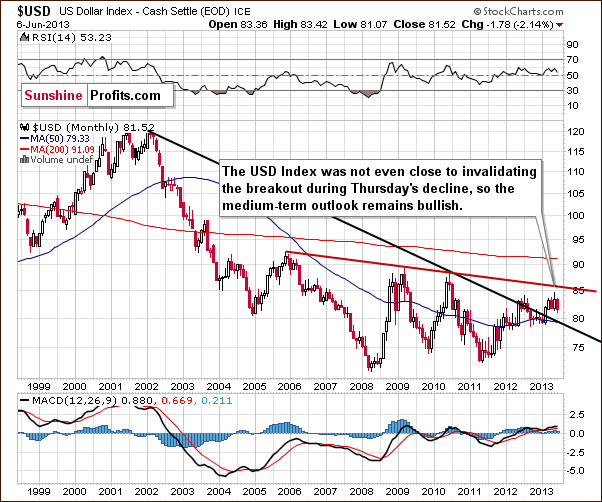
In this week’s long-term USD Index chart we see the index is still above the declining support line and the bullish medium-term outlook has not been invalidated here. That’s why last week’s decline has very little impact from this perspective. We discussed the underperformance of the precious metals relative to the USD Index several times last week beginning with Monday’s Market Alert.
… gold is responding strongly to the dollar’s rallies but responds less significantly to its declines. This is a bearish situation as it means that gold would likely decline even if the USD was just trading sideways.
This underperformance (responding less significantly to declines) was clearly taken to the extreme on Thursday.
The situation remains bullish for the USD Index. Does it look bullish for the general stock market, too? Let’s find out.

As we wrote in our essay on gold, stocks and the dollar on May 17,2013:
The situation is overbought on a short-term basis, but we do not expect to see an invalidation of the breakout above the 2007 high. If anything, we could see stocks move back to this level, which could further verify the breakout and allow them to gather strength in advance of the next rally.
Although the last correction was deeper than the previous one it doesn’t change the overall picture of the market. As long as stocks are able to hold up above the 2007 high the uptrend is not threatened. That’s why we think that the bottom for the latest decline may be in. The main buyers arguments are certainly two support lines because price levels bounced off the intersection of them.
This could mean that the bottom in the stock market is in anyway.
Now that we know how the situation looks from the perspective of the dollar and the stock market, it’s time to take a look at the yellow metal itself. (Click HERE or on image for larger view)
In this week’s very long-term gold chart, we see that the trend remains down. Despite a $20 move up last week the outlook continues to be bearish (it’s hard to take this small increase as a sign of improvement especially as we consider the whole decline.
Gold could still decline heavily based on the long-term cyclical turning point, which is due approximately this week. In both 2008 and 2009, local tops formed slightly after the cyclical turning point, so it is possible that the reversal in the downtrend won’t be seen until after the cyclical turning point once again, leaving a number of days in which further declines could be seen.
Summing up, the long-term outlook is bullish for the USD Index at this time. As for stocks, the situation remains bullish for the medium term, and although the last correction was deeper than previous one we don’t expect to see a bearish trend immediately. It seems that higher stock prices will be seen without further declines. Finally, gold’s picture provides us with bearish indications.
Overall, it seems that the final bottom in the yellow metal is not yet in.
We know keeping an eye on the market is very important to you, as you care about your savings and that’s why we hope you’ve enjoyed reading this essay and that it will help you to decide whether or not buy gold Asian style, anytime soon.
Thank you for reading. Have a great and profitable week!
Przemyslaw Radomski, CFA
Founder, Editor-in-chief
Gold Investment & Silver Investment Website – SunshineProfits.com
* * * * *
Disclaimer
All essays, research and information found above represent analyses and opinions of Przemyslaw Radomski, CFA and Sunshine Profits’ associates only. As such, it may prove wrong and be a subject to change without notice. Opinions and analyses were based on data available to authors of respective essays at the time of writing. Although the information provided above is based on careful research and sources that are believed to be accurate, Przemyslaw Radomski, CFA and his associates do not guarantee the accuracy or thoroughness of the data or information reported. The opinions published above are neither an offer nor a recommendation to purchase or sell any securities. Mr. Radomski is not a Registered Securities Advisor. By reading Przemyslaw Radomski’s, CFA reports you fully agree that he will not be held responsible or liable for any decisions you make regarding any information provided in these reports. Investing, trading and speculation in any financial markets may involve high risk of loss. Przemyslaw Radomski, CFA, Sunshine Profits’ employees and affiliates as well as members of their families may have a short or long position in any securities, including those mentioned in any of the reports or essays, and may make additional purchases and/or sales of those securities without notice.


-
I know Mike is a very solid investor and respect his opinions very much. So if he says pay attention to this or that - I will.
~ Dale G.
-
I've started managing my own investments so view Michael's site as a one-stop shop from which to get information and perspectives.
~ Dave E.
-
Michael offers easy reading, honest, common sense information that anyone can use in a practical manner.
~ der_al.
-
A sane voice in a scrambled investment world.
~ Ed R.
Inside Edge Pro Contributors

Greg Weldon

Josef Schachter

Tyler Bollhorn

Ryan Irvine

Paul Beattie

Martin Straith

Patrick Ceresna

Mark Leibovit

James Thorne

Victor Adair


